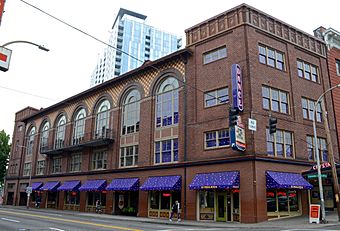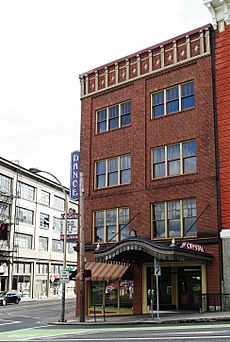Crystal Ballroom (Portland, Oregon) facts for kids
Quick facts for kids |
|
|
Cotillion Hall
|
|

From the northwest in 2017
|
|
| Lua error in Module:Location_map at line 416: Malformed coordinates value. | |
| Location | 1332 W Burnside Street Portland, Oregon |
|---|---|
| Built | 1913–1914 |
| Architect | Robert F. Tegan |
| Architectural style | Romanesque Revival |
| NRHP reference No. | 79002130 |
| Added to NRHP | March 9, 1979 |
The Crystal Ballroom, originally called Cotillion Hall, is a famous old building in Portland, Oregon, United States. It was built in 1914 as a place for dancing. Many dance events were held there, even during the tough times of the Great Depression. Since the 1960s, the hall has hosted many popular music artists. It has also been a place for beat poetry and other fun shows.
Contents
History of the Crystal Ballroom
The building we now call the Crystal Ballroom was built between 1913 and 1914. It first opened in early 1914 as Ringler's Cotillion Hall.
Montrose Ringler first owned the ballroom. But in the early 1920s, new rules made it hard for places that played jazz and held dances. Ringler lost the ballroom because of this.
Dad Watson bought the ballroom in the mid-1920s. During his time, it was mostly used for square dances. After Watson passed away in the 1930s, Ralph Farrier took over. He renamed it the Crystal Ballroom. Farrier kept holding square dances there through the 1950s.
In the early 1960s, the ballroom needed more money. So, new types of acts started performing. These included gypsy brass bands and R&B artists. Famous musicians like James Brown, Marvin Gaye, and Ike & Tina Turner played there.
In 1967, the Crystal Ballroom hosted many psychedelic rock bands. Groups like the Grateful Dead, Blue Cheer, and The Electric Prunes performed. However, this stopped in 1968. People were worried about how this music might affect young people in Portland.
From the 1970s to the mid-1990s, the ballroom was not used for public events. Instead, it became a place where artists lived and worked. They used it as studio space and sometimes held private parties. In 1979, the building was added to the National Register of Historic Places. It was listed under its original name, Cotillion Hall.
In 1997, a company called McMenamins reopened the ballroom. They added a bar and restaurant on the first floor. A brewery and a new dance floor were built on the second floor. The main ballroom on the third floor was also fixed up. This main ballroom has a special "floating" dance floor. When it was built, it was thought to be the only one on the West Coast. It might still be the only one left in the United States today.
After the Crystal Ballroom reopened, McMenamins also expanded the nearby Crystal Hotel. The hotel's 51 guest rooms are named after songs or performances from the ballroom's history. The hotel also hosts concerts before and after shows at the ballroom.
Around 2000 or 2001, a large opening was cut into the main ballroom floor. This was done to create more fire exits. It allowed more tickets to be sold for live music events. This opening is possibly the only one of its kind in a "floating" dance floor in the United States.
You can even take ballroom dance lessons there every Sunday.
On April 14, 2014, the ballroom had to be emptied during a show. This happened because a support beam might have cracked.
Many bands from Oregon have played at the Crystal Ballroom. These include Portland's Everclear in 2001 and Cherry Poppin Daddies in 2002. Portland's The Decemberists played in 2014. Other bands like Modest Mouse (from Seattle) in 2004, The Shins (from New Mexico) in 2005, and Portugal. The Man (from Alaska) in 2017 also performed there.
Is the Jimi Hendrix Story True?
There's a popular story in Portland about Jimi Hendrix. The story says that on April 5, 1965, Little Richard fired Jimi Hendrix. This supposedly happened onstage during a concert at the ballroom. The story claims Little Richard fired him for not being skilled enough. The Crystal Ballroom's marketing has even used this story.
We know that Little Richard did play at the Crystal Ballroom on that date. We also know that Hendrix was in his touring band for much of 1965. Plus, the two musicians did have a difficult relationship. Hendrix left and rejoined Little Richard's tour several times.
However, there is no proof that Hendrix played with Little Richard on that specific date. There's also no record that Little Richard fired any musicians onstage that day. Hendrix also played with Little Richard at other shows later that same month. By then, Hendrix was already known as a very talented guitarist. So, this story is likely just an urban legend.
What's Inside the Crystal Ballroom?
The Crystal Ballroom is on the third floor of the building. It has very high ceilings and a balcony. You can also see grand chandeliers, beautiful murals, and large arched windows.
The room can be rented for group meetings. It can hold up to 1,000 people. For concerts, it can fit up to 1,500 people standing. If people are seated, it can hold 850.
Images for kids
-
Slowdive plays at Crystal Ballroom in 2014.




